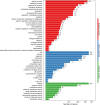Intestinal transcriptional profiling reveals fava bean-induced immune response in DBA/1 mice
- PMID: 30823938
- PMCID: PMC6396536
- DOI: 10.1186/s40659-019-0216-9
Intestinal transcriptional profiling reveals fava bean-induced immune response in DBA/1 mice
Abstract
Background: Fava beans (FBs) have long been used as food, and their principal disadvantage is derived from their haemotoxicity. We hypothesized that FB ingestion alters the intestinal gene expression pattern, thereby inducing an immune response.
Results: In-depth sequence analysis identified 769 differentially expressed genes (DEGs) associated with the intestine in FB-treated DBA/1 mouse intestines. The identified genes were shown to be associated with biological processes (such as response to stimulus and immune system processes), human disease pathways (such as infectious diseases, endocrine and metabolic diseases, and immune diseases), and organismal system pathways (such as the digestive system, endocrine system, environmental adaptation, and immune system). Moreover, plasma total immunoglobulin E (IgE), histamine, interleukin (IL)-4 and IL-13 levels were significantly increased when the mice were treated with FBs.
Conclusions: These results demonstrated that FBs affect the intestinal immune response and IgE and cytokine secretion in DBA/1 mice.
Keywords: DEGs; Differentially expressed genes; Fava beans; Histamine; Immune response; Total IgE.
Figures





Similar articles
-
Hepatic transcriptional profiling response to fava bean-induced oxidative stress in glucose-6-phosphate dehydrogenase-deficient mice.Gene. 2018 Apr 30;652:66-77. doi: 10.1016/j.gene.2018.02.014. Epub 2018 Feb 8. Gene. 2018. PMID: 29428800
-
Gas Chromatography/Mass Spectrometry-Based Metabolomic Profiling Reveals Alterations in Mouse Plasma and Liver in Response to Fava Beans.PLoS One. 2016 Mar 16;11(3):e0151103. doi: 10.1371/journal.pone.0151103. eCollection 2016. PLoS One. 2016. PMID: 26981882 Free PMC article.
-
Do favic patients resume fava beans ingestion later in their life, a study for this, and a new hypothesis for favism etiology.Hematol Oncol Stem Cell Ther. 2013 Mar;6(1):9-13. doi: 10.1016/j.hemonc.2013.03.002. Epub 2013 Mar 22. Hematol Oncol Stem Cell Ther. 2013. PMID: 23664599
-
Pathophysiology of favism.Folia Haematol Int Mag Klin Morphol Blutforsch. 1989;116(5):745-52. Folia Haematol Int Mag Klin Morphol Blutforsch. 1989. PMID: 2481620 Review.
-
IL-33 and the intestine: The good, the bad, and the inflammatory.Cytokine. 2017 Dec;100:1-10. doi: 10.1016/j.cyto.2017.06.017. Epub 2017 Jul 4. Cytokine. 2017. PMID: 28687373 Free PMC article. Review.
Cited by
-
HSPB8 is a Potential Prognostic Biomarker that Correlates With Immune Cell Infiltration in Bladder Cancer.Front Genet. 2022 Mar 7;13:804858. doi: 10.3389/fgene.2022.804858. eCollection 2022. Front Genet. 2022. PMID: 35330734 Free PMC article.
References
-
- Crépon K, Marget P, Peyronnet C, Carrouée B, Arese P, Duc G. Nutritional value of faba bean (Vicia faba L.) seeds for feed and food. Field Crops Res. 2010;115(3):329–339. doi: 10.1016/j.fcr.2009.09.016. - DOI
-
- Macarulla MT, Medina C, De Diego MA, Chavarri M, Zulet MA, Martinez JA, Noel-Suberville C, Higueret P, Portillo MP. Effects of the whole seed and a protein isolate of faba bean (Vicia faba) on the cholesterol metabolism of hypercholesterolaemic rats. Br J Nutr. 2001;85(5):607–614. doi: 10.1079/BJN2000330. - DOI - PubMed
MeSH terms
Grants and funding
LinkOut - more resources
Full Text Sources

